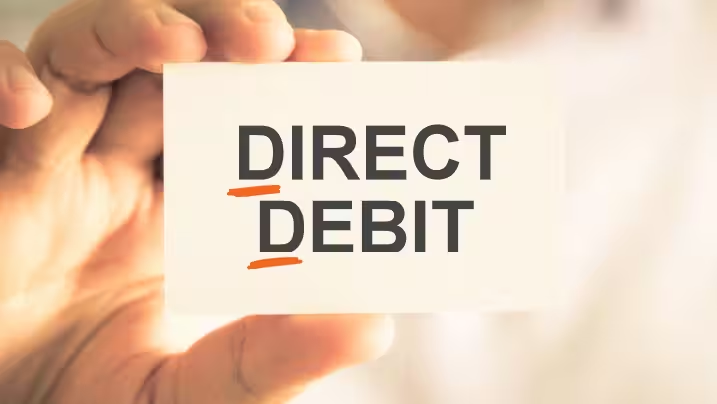Tired of waiting for customers to pay invoices? With automated direct debit payments, you get paid on time and spend less time chasing bills.
It is also more convenient for customers, as they no longer have to remember manual transfers or risk late fees. Direct debit is a win for both sides.
What Is A Direct Debit Payment?

A direct debit is an automatic transfer from a customer’s bank account to a business. Unlike a one-off manual payment, direct debits are pre-authorised and ongoing. For consumers, this is common for recurring bills such as a phone plan, streaming subscription, or gym membership.
The customer gives permission for the business to deduct funds on an agreed schedule. Once approved, the process runs automatically, reducing the chance of missed or late payments.
For businesses, it is as simple as collecting a direct debit authority from the customer and passing that to your provider, who manages the transfers through the banking system.
Who Should Use Direct Debits?
Direct debit is ideal for any business that bills customers regularly. Gyms, schools, subscription services, and agencies that work on retainers are some of the biggest beneficiaries.
It is especially valuable for memberships and subscriptions where customers expect uninterrupted service. For example, a gym member does not want to think about renewing access every week. They just want to swipe in and train.
Why Use Direct Debit For Your Business?
Consistency and Cash Flow
Direct debit provides predictable income. Instead of wondering when or if payments will land, you know exactly when funds will arrive. This makes it easier to budget, pay suppliers, and plan for growth.
Save Time
Automated payments free up hours of admin. No more manual reminders, reconciliations, or awkward follow-up calls. Both you and your customers can relax knowing payments are handled in the background.
Cost-Effective
Direct debits typically cost less to process than credit card payments. Card gateways often charge 3 to 5 per cent per transaction, while direct debit fees are much lower, saving money with every payment cycle.
Flexibility
Direct debit arrangements can be adjusted without new approvals. You can change amounts or billing frequency as needed, and customers can request preferred payment dates. This flexibility keeps things simple for both parties.
Are Direct Debits Secure?
Yes. Direct debits are processed through the banking system, making them one of the most secure ways to move money.
Customers are not entering sensitive card details online, and businesses that use PCI DSS compliant providers can assure customers their data is safe.
How To Set Up Direct Debit For Your Business
- Choose a provider
Select a direct debit provider that integrates with your current systems. Look for one that accepts multiple payment types, not just bank transfers. - Send customers an authority form
Provide a direct debit request form for customers to nominate their account. This becomes their authorisation for recurring payments. - Set frequency and amounts
Once approved, you can set up the schedule and amounts. Customers appreciate being asked if they have a preferred date, such as after payday. - Send reminders
Notify customers before each payment is deducted. This reduces the chance of failed payments and shows professionalism.
Once these steps are complete, payments flow automatically, freeing you to focus on your business.
What Is A Direct Debit Mandate?
You might also hear the term “direct debit mandate” or “instruction.” This is simply the authorisation that allows your provider to collect payments. It must be signed before funds can be taken. Clear communication about this process builds trust and avoids confusion.
What If A Customer Has Insufficient Funds?
If a payment fails, most providers will attempt the transfer again a few days later. The customer may incur a dishonour fee from their bank, but your business is not penalised.
Failed payments usually happen because of insufficient funds, and while it can be frustrating, it is often not intentional. The key is to handle these situations with good customer service. Communicate clearly, explain any fees, and work with the customer to resolve the issue. This can turn a negative experience into a chance to build stronger loyalty.
How Can Customers Cancel A Direct Debit?
Customers can usually cancel a direct debit by notifying their bank at least 24 hours before payment is due. The bank then informs you of the cancellation. Direct debits are not contracts. They are simply an authority that can be withdrawn.
To maintain trust, make it easy for customers to cancel if they wish. If payments go through after a valid cancellation, refund them promptly. Continuing to collect payments after a cancellation request is a quick way to lose credibility.
Direct Debit Services With PayChoice
PayChoice is trusted by over 3,000 Australian businesses and has more than 15 years of experience in payments. The platform allows you to manage direct debits, credit card transactions, online payments, and real-time transfers with industry-leading PCI DSS security.
With PayChoice, you can integrate payments directly into your systems, save time chasing invoices, and provide your customers with a smooth and reliable experience. If you are ready to simplify payments and improve your cash flow, get in touch with our team today and we will help you get started.

Meet Suhas Harshe, a financial advisor committed to assisting people and businesses in confidently understanding and managing the complexities of the financial world. Suhas has shared his knowledge on various topics like business, investment strategies, optimizing taxes, and promoting financial well-being through articles in InvestmentDose.com


